
Posts Tagged: research
Good fire is back at the Hopland Research and Extension Center
Fire has been part of indigenous stewardship in California since time immemorial. These fire practices were deeply connected to cultural traditions, food ways, and enhanced the resilience of landscapes. Using fire for research and land management at the UC ANR Hopland Research and Extension Center (HREC) dates back to the early 1950s and fire was used as an effective tool for maintaining the health of the landscape for many years. However, the regulations and paperwork permitting controlled burns became increasingly restrictive after the catastrophic wildfires of 2017.
Thanks to three years of perseverance by John Bailey, HREC director, and with help from trained UC ANR advisors and staff, we were able to execute a research burn once again, instead of relying on the more restrictive CalFire Vegetation Management Plan process. By carefully reintroducing fire, a tool essential for rangeland and oak woodland stewardship, we want to be able to use good fire for research and to recover biodiversity and make the landscape more climate resilient.
On Nov. 8, 2024, HREC successfully conducted a prescribed burn as part of ongoing research to advance the restoration of a unique perennial wetland. This prescribed burn is part of a larger initiative to enhance native biodiversity and control invasive species. Fire was used as a natural disturbance to open up the dense Tule stands surrounding the pond to create a habitat mosaic with a diversity of plant species and habitat structure for native frogs and other pond life.
The burn was led by UCANR staff and academics, including Jeff Stackhouse, UC Cooperative Extension natural resource advisor, and Mike Jones, UCCE forestry advisor, whose leadership ensured its successful execution. We also had significant community participation from members of theHopland Band ofPomo Indians, including their Environmental Protection Agency director, as well as Grizzly Corps members, researchers and volunteers.
This event provided an opportunity for the diverse group to learn about controlled burns, engage in fire safety education, and explore how such practices contribute to ecological resilience. By involving community members in the process, the event not only restored habitat but also fostered a deeper understanding of fire's role in ecosystem health and stewardship.
HREC plans to work with UC ANR leadership and the UC ANR Fire Network to establish clear policies for conducting regular burns for research, stewardship and extension. Additionally, HREC will continue partnering with CalFire, leveraging their capacity for larger-scale projects, ensuring a variety of pathways are available for safely conducting prescribed fire and to strengthen the UC-CalFire relationship for better land stewardship outcomes statewide.
Outstanding PBS Deep Look Video: 'Why Do Sunflowers Face the Sunrise?'
Sunflowers bring out the best in us. They bring us joy, happiness, hope and unity. But wait...

The newly released PBS Deep Look video "Why Do Sunflowers Face the Sunrise?" is a crowd favorite. (Screen shot)
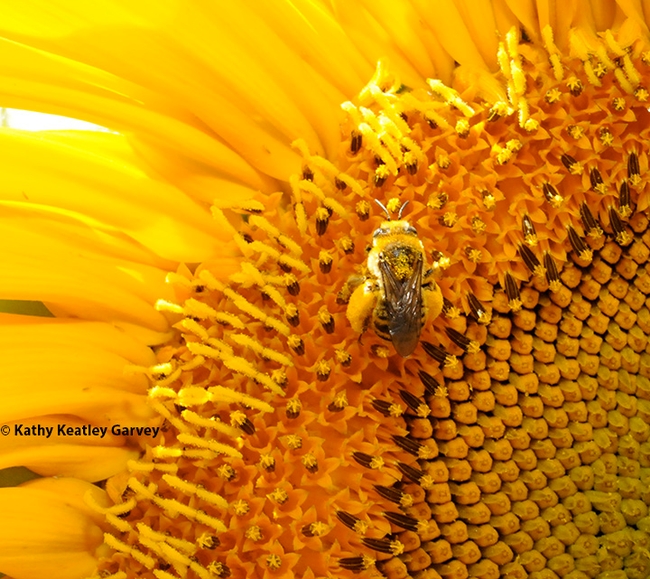
A bee commonly found on sunflowers is Epimelissodes obliqua expurgata, formerly known as Svastra obliqua expurgata. (Photo by Kathy Keatley Garvey)
Bumble Bees: Feeling Impact of Climate Change
We remember the reaction of Robbin Thorp (1933-2019), UC Davis distinguished emeritus...
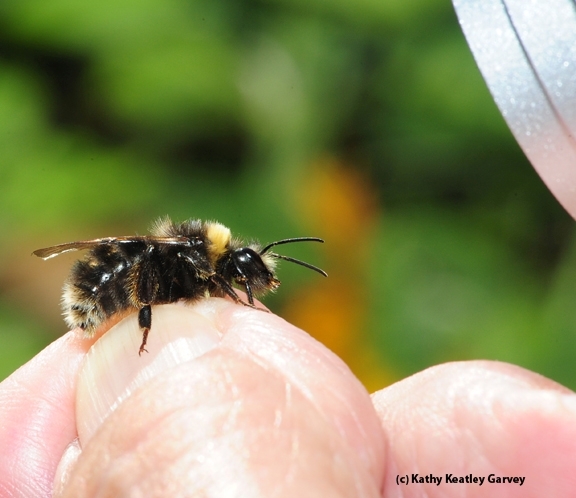
UC Davis research shows that rising temperatures are particularly alarming to some bumble bee species, including the Western bumble bee, Bombus occidentalis. This one was located on Aug. 15, 2012 in the Mt. Shasta area. (Photo by Kathy Keatley Garvey)
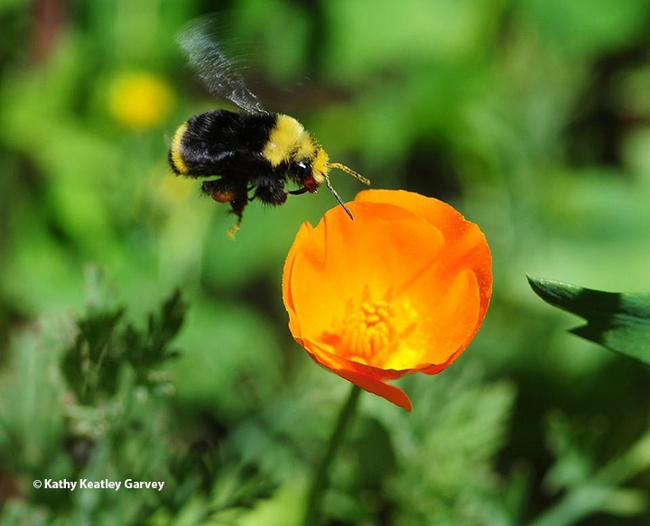
UC Davis researchers found that one of "the winners" in their climate change study is the yellow-faced bumble bee, Bombus vosnesenskii, shown here heading for a California golden poppy. (Photo by Kathy Keatley Garvey)
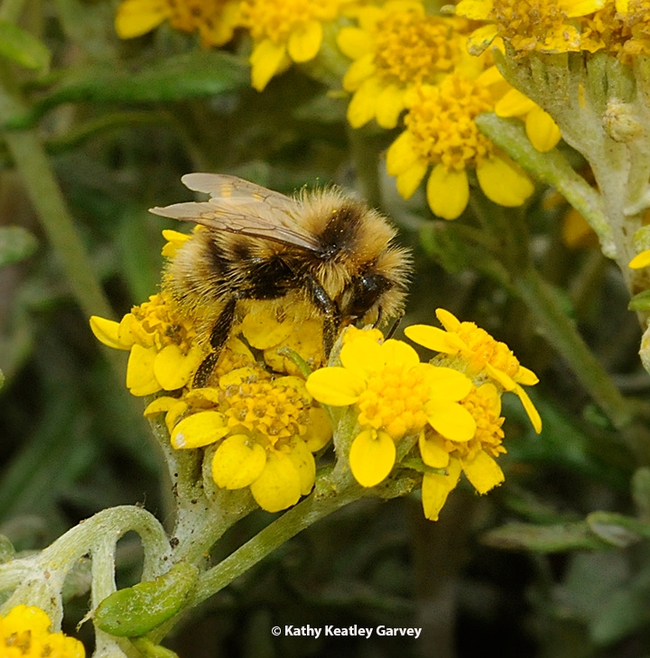
A male bumble bee, Bombus bifarius, nectaring on coastal goldfield, Lasthenia minor, at Bodega Bay. A UC Davis study shows that the rising temperatures are particularly alarming to a number of species, including this one. (Photo by Kathy Keatley Garvey)
Postharvest Center: New research focus and outreach
Still providing the world with top-notch information
UC Davis has been a leading source of information for people handling, packaging and transporting crops since the beginnings of the Postharvest Research and Extension Center in 1979. Now, the center is strengthening its focus on the needs of industry, offering fresh courses, weaving strategic partnerships and expanding into digital media, all while building up its research capacity to better serve the needs of the produce industry.
“We're asking people in the industry, ‘How can we support you? How can we better listen to you?' We want people to know we're not disconnected know-it-alls,” said new center co-director Bárbara Blanco-Ulate, an associate professor in the UC Davis Department of Plant Sciences. “We're getting more faculty involvement, people with expertise in related fields such as quality engineering and safety, as well as bringing in emeriti faculty and people from around California. We're forming partnerships with organizations around the world, and we've opened up to people from other institutions around the country.”
“The larger the network, the more things we can do,” added fellow co-director Irwin R. Donis-Gonzalez, an associate professor of UC Cooperative Extension in the Department of Biological and Agricultural Engineering.
The foundation: Expanded research
The new co-directors will beef up the center's applied science component with the hiring of a research specialist. They aim to provide new information that can be used industry-wide as companies explore new ways to handle and store fresh produce.
“We're building the capacity to respond to industry requests for research,” Blanco-Ulate said.
New courses, national reach
Their first workshop, held recently, demonstrates the center's renewed vision and commitment to broad networking: The Agricultural Water Systems Workshop addressed current concerns around water management and risks to food safety. Partners in the course included the Western Growers Association, the University of Arizona, the University of Florida and Salinas-based Taylor Fresh Foods, Inc.
Courses given over the past several years that have been recorded will be posted to the center's new, online video library and to the center's YouTube channel.
“People can watch those courses for free,” Blanco-Ulate said. In addition, new courses will be offered in-person and hybrid.
The co-directors are working with the University of California to offer continuing and professional education credits to course participants.
Online resources – many for free!
The center's website features a database with scores of free product fact sheets, which are downloaded by users around the world. The fact sheets are so highly regarded that they are considered expert evidence in legal proceedings, Blanco-Ulate said. Visitors to the website can also find links to research papers published by UC Davis faculty, including seminal works by Adel Kader, who founded the center.
Books are offered through the center's online bookstore and include titles through UC Agriculture and Natural Resources. Ten new titles are being planned, including topic-specific updates taken from previous classics.
Debunking myths: Ethylene
A new newsletter deals with a new problem: Misinformation about food and food handling that spreads through social media. One example is the use of ethylene to ripen produce such as bananas, so that they can be safely stored until ready for the consumer.
“Ethylene is safe for humans and does not leave any harmful residue on produce,” Donis-Gonzalez wrote in the center's latest newsletter. Even better news, he added: The levels of ethylene used on food are a tiny fraction of the concentrations that would be needed to create an explosion, one of the false alarms being raised in social media.
Evolving with the times
After 47 years of service, these and more updates will keep the center at the forefront of an evolving postharvest world. The top goal: Meet the needs of agriculturalists, industry and consumers.
“We are adapting to new needs, with both the resources and the workshop we're offering,” Donis-Gonzalez said.
“As a land-grant institution, we take our outreach mission seriously,” Blanco-Ulate added.
Related links
More about the UC Davis Postharvest Research and Extension Center.
This story first appeared on the UC Davis Department of Plant Sciences site.
The Bees, The Team, The Honor
When UC Davis distinguished professor Walter Leal, recipient of a UC Davis Academic...
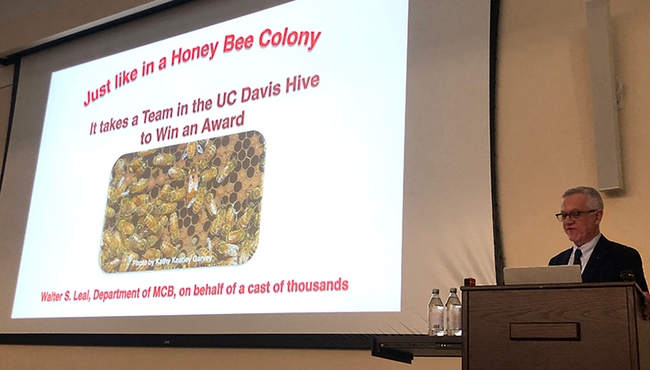
UC Davis distinguished professor Walter Leal delivering his Academic Senate Faculty Distinguished Research Award lecture. (Photo by Kathy Keatley Garvey)
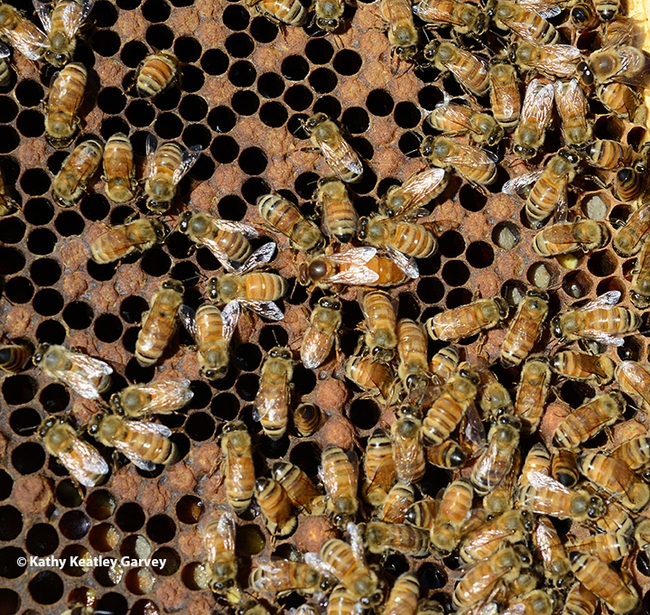
Inside a honey bee colony: worker bees and the queen. (Photo by Kathy Keatley Garvey)







